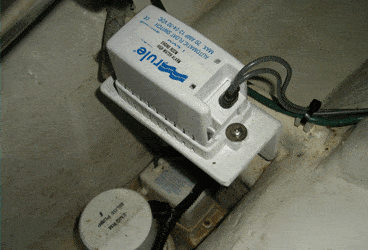
High-Water Alarm
Given the obvious potential danger presented by the water surrounding a sailboat, I’m surprised at how few cruising vessels I inspect have high-water alarms, which can quickly alert crews that flooding is occurring and the bilge-water level is rising. Although their value is self-evident, these warning systems are also necessary for vessels with enclosed accommodation spaces to be compliant with American Boat & Yacht Council standards.
The good news is that the design and installation of high-water alarms are rather simple matters. Easily fashioned by an electrically savvy do-it-yourselfer or available as proprietary kits, high-water alarms are the first line of defense against both incidental and catastrophic flooding. Like automobile airbags, GFI electrical receptacles, or many other systems that are rarely if ever used—you hope—for their intended purposes, the high-water alarm must be reliable when its time to perform comes.
In its simplest form, a bilge high-water alarm can be made up utilizing a conventional pump float switch and an audible alarm, preferably one that’s impossible to ignore; the traditional school recess bell comes to mind. Others may rely on piezoelectric whistles whose tone can only be described as ear splitting. Some more sophisticated bilge-pump switches incorporate a high-water-alarm component, essentially sounding if the pump remains on for too long. If your boat’s bilges are constrained in size, this combined approach may be desirable.
The importance of the location of the float switch (or switches, depending on the size of the vessel) can’t be overemphasized. In many cases, I encounter high-water alarms installed well above the normal level of bilge-water accumulation. When I inquire with the builder, yard, or do-it-yourselfer as to why the switch has been installed so high, the response usually centers on a desire to avoid false alarms. Rest assured, a high-water-alarm switch installed a scant 2 or 3 inches above the primary bilge-pump float switch will only sound if water reaches that level. If it does, it’s very likely that something is amiss, which warrants investigation. It’s been my practice to install alarm switches in this manner, just high enough to prevent false alarms and no higher. I’ve done this for many years, and not one has ever cried wolf; when they’ve gone off, there’s always been genuine flooding.
For obvious reasons, wiring for the components of high-water alarms, particularly those located in the bilge, must be robust and waterproof. The system should be tested by actuating the float switch at least monthly and by filling the bilge with water—to test both the high-water alarm and bilge-pump system—at least annually.
If flooding should occur as a result of the batteries going dead or otherwise malfunctioning, as often is the case, then it makes sense that the alarm should operate independently of that power supply. Proprietary alarms available from Ultra Safety Systems (www.tefgel.com) use a pair of 9-volt transistor batteries for this very reason.
If you wish to rely on the alarm to alert others while your boat’s anchored, moored, or sitting dockside, then include an annunciator (again, a loud one), and consider adding a strobe, for additional impact, on deck as well. For the expense, high-water alarms represent one of the better returns on your onboard investment.
Steve D’Antonio offers services for boat owners and buyers through Steve D’Antonio Marine Consulting (www.stevedmarineconsulting.com).








